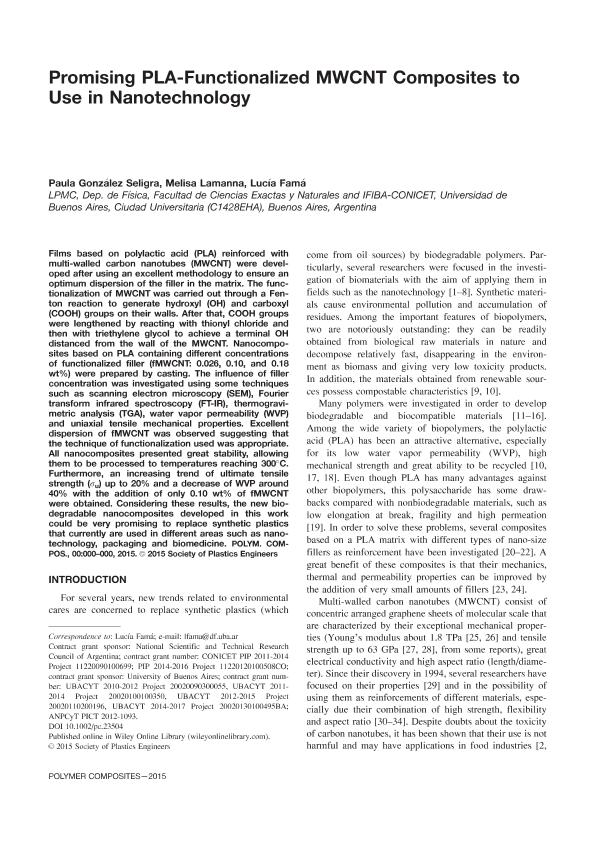Artículo
Promising PLA-functionalized MWCNT composites to use in nanotechnology
Fecha de publicación:
04/2015
Editorial:
John Wiley & Sons Inc
Revista:
Polymer Composites
ISSN:
0272-8397
Idioma:
Inglés
Tipo de recurso:
Artículo publicado
Clasificación temática:
Resumen
Films based on polylactic acid (PLA) reinforced with multi-walled carbon nanotubes (MWCNT) were developed after using an excellent methodology to ensure an optimum dispersion of the filler in the matrix. The functionalization of MWCNT was carried out through a Fenton reaction to generate hydroxyl (OH) and carboxyl (COOH) groups on their walls. After that, COOH groups were lengthened by reacting with thionyl chloride and then with triethylene glycol to achieve a terminal OH distanced from the wall of the MWCNT. Nanocomposites based on PLA containing different concentrations of functionalized filler (fMWCNT: 0.026 wt%, 0.10 wt% and 0.18 wt%) were prepared by casting. The influence of filler concentration was investigated using some techniques such as scanning electron microscopy (SEM), Fourier transform infrared spectroscopy (FT-IR), thermogravimetric analysis (TGA), water vapor permeability (WVP) and uniaxial tensile mechanical properties. Excellent dispersion of fMWCNT was observed suggesting that the technique of functionalization used was appropriate. All nanocomposites presented great stability, allowing them to be processed to temperatures reaching 300 ºC. Furthermore, an increasing trend of ultimate tensile strength (u) up to 20 % and a decrease of WVP around 40 % with the addition of only 0.10 wt% of fMWCNT were obtained. Considering these results, the new biodegradable nanocomposites developed in this work could be very promising to replace synthetic plastics that currently are used in different areas such as nanotechnology, packaging and biomedicine.
Palabras clave:
Pla
,
Carbon Nanotubes
,
Nanocomposites
Archivos asociados
Licencia
Identificadores
Colecciones
Articulos(IFIBA)
Articulos de INST.DE FISICA DE BUENOS AIRES
Articulos de INST.DE FISICA DE BUENOS AIRES
Citación
Gonzales Seligra, Paula; Lamanna, Melisa Elsa; Fama, Lucia Mercedes; Promising PLA-functionalized MWCNT composites to use in nanotechnology; John Wiley & Sons Inc; Polymer Composites; 37; 10; 4-2015; 3066-3072
Compartir
Altmétricas




